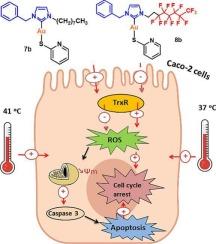N-heterocyclic carbene gold(I) derivatives with long aliphatic side chains as potential anticancer agents in colon cancer
IF 3.2
2区 化学
Q2 BIOCHEMISTRY & MOLECULAR BIOLOGY
引用次数: 0
Abstract
Mild hyperthermia has emerged as a powerful tool in cancer therapy, prompting the development of materials that respond to heat with enhanced therapeutic action. Gold(I)-NHC complexes are emerging as promising anticancer agents due to their stability, tunability, and ability to inhibit sulfur- and selenium-dependent enzymes overexpressed in tumors. In this study, we synthesised carbene–gold(I) derivatives bearing fluorous and hydrocarbon chains to assess the role of polyfluorinated groups and the impact of mild hyperthermia (41 °C) on their cytotoxic activity. The compounds exhibited significant antiproliferative effects against Caco-2/TC7 colon carcinoma cells at both 37 °C and 41 °C. This activity may be associated with alterations in the levels of ROS (reactive oxygen species) within the cells and the activity of TrxR (thioredoxin reductase), resulting in modifications to the intracellular redox state and subsequent disruptions to the cell cycle. Under hyperthermic conditions, cytotoxicity was further enhanced via mitochondrial depolarization and activation of caspase-3-mediated apoptosis. Notably, fluorinated complexes displayed superior cytotoxicity compared to their alkylated analogues, highlighting the relevance of polyfluorinated chains in boosting therapeutic efficacy under heat-triggered conditions.

具有长脂肪侧链的n -杂环碳金(I)衍生物在结肠癌中的潜在抗癌作用
轻度热疗已成为癌症治疗的有力工具,促使材料的发展,以增强治疗作用响应热。金(I)- nhc配合物由于其稳定性、可调性以及抑制肿瘤中硫依赖性和硒依赖性酶过表达的能力,正成为一种有前景的抗癌药物。在这项研究中,我们合成了含氟和碳氢化合物链的碳金(I)衍生物,以评估多氟化基团的作用以及轻度高温(41°C)对其细胞毒性活性的影响。在37°C和41°C条件下,化合物对Caco-2/TC7结肠癌细胞均有明显的抗增殖作用。这种活性可能与细胞内ROS(活性氧)水平和TrxR(硫氧还蛋白还原酶)活性的改变有关,从而导致细胞内氧化还原状态的改变和随后的细胞周期中断。在高温条件下,细胞毒性通过线粒体去极化和激活caspase-3介导的凋亡进一步增强。值得注意的是,与烷基化类似物相比,氟化复合物显示出更高的细胞毒性,这突出了多氟化链在热触发条件下提高治疗效果的相关性。
本文章由计算机程序翻译,如有差异,请以英文原文为准。
求助全文
约1分钟内获得全文
求助全文
来源期刊

Journal of Inorganic Biochemistry
生物-生化与分子生物学
CiteScore
7.00
自引率
10.30%
发文量
336
审稿时长
41 days
期刊介绍:
The Journal of Inorganic Biochemistry is an established international forum for research in all aspects of Biological Inorganic Chemistry. Original papers of a high scientific level are published in the form of Articles (full length papers), Short Communications, Focused Reviews and Bioinorganic Methods. Topics include: the chemistry, structure and function of metalloenzymes; the interaction of inorganic ions and molecules with proteins and nucleic acids; the synthesis and properties of coordination complexes of biological interest including both structural and functional model systems; the function of metal- containing systems in the regulation of gene expression; the role of metals in medicine; the application of spectroscopic methods to determine the structure of metallobiomolecules; the preparation and characterization of metal-based biomaterials; and related systems. The emphasis of the Journal is on the structure and mechanism of action of metallobiomolecules.
 求助内容:
求助内容: 应助结果提醒方式:
应助结果提醒方式:


